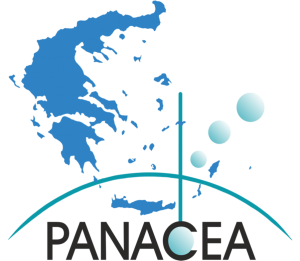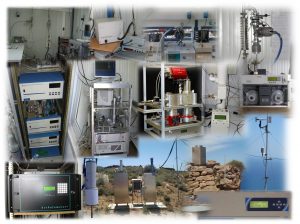 At Finokalia Station, a wide range of measurements are carried out on a continuous basis to characterize the atmosphere, either in real time or by collecting samples for subsequent laboratory analysis. The station’s instrumentation includes new technology measuring devices:
At Finokalia Station, a wide range of measurements are carried out on a continuous basis to characterize the atmosphere, either in real time or by collecting samples for subsequent laboratory analysis. The station’s instrumentation includes new technology measuring devices:
•Weather station: Speed – wind direction (RM Young Co. 05103), Relative humidity – temperature (Rotronic HC2A-S3), Total solar radiation (Kipp and Zonen, pyranometer CM3), Barometric pressure (Vaisala PTB110), Height (Rain height) RM Young Co. 52203)
• UV-A and UV-B solar radiation sensors
• Automatic gas pollutant analyzers: Ozone (O3) (Thermo 49C and 49i), Nitrogen Oxides (NO, NO2) (Thermo 42C and 42i), Carbon Monoxide (CO) (Thermo 48C and 49i)
• Automatic analyzer for greenhouse gas measurements (Picarro): Carbon dioxide (CO2), Carbon monoxide (CO), Methane (CH4)
• Automatic Radon (Rn-222) and Thoronium (Th) Concentrator
• Absorption Spectrometers – Automatic Elemental Carbon Analyzer (Magee Scientific AE31 and AE33 and Multiangle Absorption Photometer (MAAP) Thermo Sci. 5012)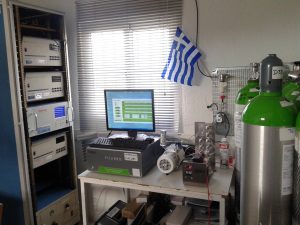
• Nebulometers (Ecotech Aurora 1000 and Aurora 3000 and two Radiance Research M903)
• Particle concentration analyzer less than 10 µm (PM10) in diameter (Thermo Sci. FH62 I-R)
• Compact Particle Counter (CPC) (TSI 3760A) and Optical (LPC) (TSI 3753A)
• Scanning Mobility Particle Sizer (SMPS) particle size distributor including CPC (TSI 3772)
• Aerosol Chemical Speciation Monitor (Aerodyne res. Inc. ACSM)
• PM10 Aerosol Collection Sampler (Leckel SEQ47 / 50).
• PM10 Aerosol Collection Sampler (Derenda PNS 16T-3.1).
• PM1 Aerosol Collection Sampler
• Automatic wet deposition system (rain)
• Aerosol dry deposition sampler
• Particle Mass Sensors (Purple air, Alphasense)
• Sunlight (CIMEL sunphotometer)
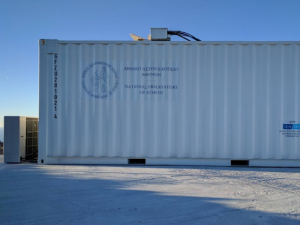 PANGEA (i.e. the PANhellenic GEophysical observatory of Antikythera), is the main station of NOA for atmospheric monitoring, aiming to expand in a superstation that will integrate observational facilities and corresponding instruments for the observation of aerosols, clouds and gases following ACTRIS and ICOS standards and definitions. The island of Antikythera in Greece, is located in between the North-west end of Crete and the South of Peloponnese (35.86 Ν, 23.81 Ε, elevation: 110 m a.s.l.). The low altitude of the island, as well as its geographical position, serve as great advantages when it comes to monitoring air masses representative of the Central Mediterranean. Since June 2018 the aerosol remote sensing facility of NOA is operating continuously by the ReACT group, including the sophisticated lidar system PollyXT and the NASA-AERONET sunphotometer.
PANGEA (i.e. the PANhellenic GEophysical observatory of Antikythera), is the main station of NOA for atmospheric monitoring, aiming to expand in a superstation that will integrate observational facilities and corresponding instruments for the observation of aerosols, clouds and gases following ACTRIS and ICOS standards and definitions. The island of Antikythera in Greece, is located in between the North-west end of Crete and the South of Peloponnese (35.86 Ν, 23.81 Ε, elevation: 110 m a.s.l.). The low altitude of the island, as well as its geographical position, serve as great advantages when it comes to monitoring air masses representative of the Central Mediterranean. Since June 2018 the aerosol remote sensing facility of NOA is operating continuously by the ReACT group, including the sophisticated lidar system PollyXT and the NASA-AERONET sunphotometer.
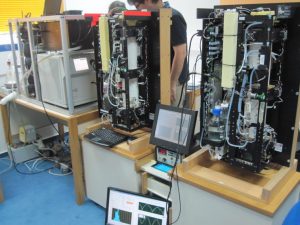
The station’s laboratory is equipped with a variety of instruments suitable for measuring chemical composition, mass concentration, size, volatility, water solubility, atmospheric particle hygroscopicity and the monitoring of certain gases. The same instruments are used in the ICE-HT’s atmospheric simulation chamber for the study of atmospheric processes.
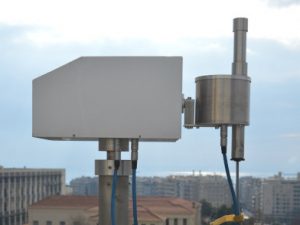 The station’s equipment includes a Lidar-DIAL remote sensing system for measuring the vertical distribution of ozone and particulate matter in the troposphere and the lower stratosphere, Brewer Spectrophotometer (Mk II) for measuring ultraviolet (UV) spectroscopy and total column of O3, SO2, Brewer (Mk III) dual monochromator spectrophotometer for measuring UV-B spectra and total O3 and SO2, DOAS Systems (Phaethon, MAX-DOAS and Long path DOAS (SANOA) for measuring the spectral optical depth of particulate matter and gaseous pollutants (eg NO2, CH2O), Multi-filter 9-ray array for measuring solar radiation in six areas between UV- B and PAR, Wide bandwidth total and ultraviolet (UV-B, erythema, UV-A), Calibration and Optical Instrumentation Radiometric Instruments, CIMEL Filter Photometer for Measuring Optical Properties of Atmospheric Atmospheres of the Atmospheric Limit Layer (wind field measurement), GRIMM analyzer for measuring the mass density of atmospheric suspensions in 31 zones from 0.25 to 32 µm, Digital Camera Cloud Imaging System, ECC Radiolabels and Ozonoblasts, for measuring the vertical distribution of atmospheric RS10, , Middle-Scale Meteorological Model (PSU / NCAR – MM5 and WRF), Photochemical Models (CAMx and UAM-V), Dispersion Model (RIMPUFF), ECHAM5 / Messyv1.4 Computational Model (fully coupled Chemistry-General Circulation Model) Atmospheric Chemistry- General Circulation Model)), KRCM Computational Model (Density Radiation-Convective-Oceanic Model), as well as Solar Radiation Propagation Models (Libradtran v1.2, TUV v4.4).
The station’s equipment includes a Lidar-DIAL remote sensing system for measuring the vertical distribution of ozone and particulate matter in the troposphere and the lower stratosphere, Brewer Spectrophotometer (Mk II) for measuring ultraviolet (UV) spectroscopy and total column of O3, SO2, Brewer (Mk III) dual monochromator spectrophotometer for measuring UV-B spectra and total O3 and SO2, DOAS Systems (Phaethon, MAX-DOAS and Long path DOAS (SANOA) for measuring the spectral optical depth of particulate matter and gaseous pollutants (eg NO2, CH2O), Multi-filter 9-ray array for measuring solar radiation in six areas between UV- B and PAR, Wide bandwidth total and ultraviolet (UV-B, erythema, UV-A), Calibration and Optical Instrumentation Radiometric Instruments, CIMEL Filter Photometer for Measuring Optical Properties of Atmospheric Atmospheres of the Atmospheric Limit Layer (wind field measurement), GRIMM analyzer for measuring the mass density of atmospheric suspensions in 31 zones from 0.25 to 32 µm, Digital Camera Cloud Imaging System, ECC Radiolabels and Ozonoblasts, for measuring the vertical distribution of atmospheric RS10, , Middle-Scale Meteorological Model (PSU / NCAR – MM5 and WRF), Photochemical Models (CAMx and UAM-V), Dispersion Model (RIMPUFF), ECHAM5 / Messyv1.4 Computational Model (fully coupled Chemistry-General Circulation Model) Atmospheric Chemistry- General Circulation Model)), KRCM Computational Model (Density Radiation-Convective-Oceanic Model), as well as Solar Radiation Propagation Models (Libradtran v1.2, TUV v4.4).
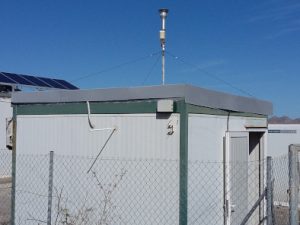
Station’s equipment includes a weather station (wind speed and direction, ground temperature, atmospheric humidity, rainfall altitude) and PM10 measuring devices, particulate matter count and O3 concentration.
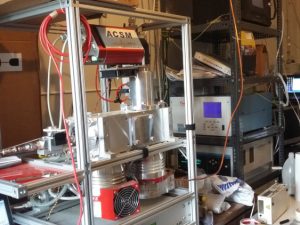 The state-of-the-art, specialized equipment of the Atmospheric Pollution Monitoring Station of Thissio of high temporal resolution includes the basic analyzers of gas (NO, NO2, O3, SO2, CO) and particulate matter (PM10, BC) pollutants, measurement systems of particle optical properties (absorption, scattering) and samplers of different size ranges of particulate matter (PM10 and PM2.5) on filter substrates for further chemical analyses at the Laboratory of Atmospheric Chemistry. In cooperation with the University of Crete (and in cases other Research and Academic entities) the station of Thissio operates as a specialized measurement hub, hosting cutting-edge equipment for continuous on-line monitoring, among others, of the chemical composition of aerosol using an Aerosol Chemical Speciation Monitor (ACSM), the water-soluble fraction of particulate matter (Particle-into-liquid Sampler;PILS) and the particle number size distribution (Scanning Mobility Particle Sizer, SMPS). Furthermore, the Mobile Air Quality Monitoring Station includes a fully equipped vehicle with instruments for the continuous measurement of atmospheric pollutants (NO, O2, O3, SO2, CO, PM10 and BC) in a specially designed space with a datalogger and a meteorological station. The mobile unit offers the flexibility of transporting equipment to any part of the Greek territory to monitor the levels of pollution in the area.
The state-of-the-art, specialized equipment of the Atmospheric Pollution Monitoring Station of Thissio of high temporal resolution includes the basic analyzers of gas (NO, NO2, O3, SO2, CO) and particulate matter (PM10, BC) pollutants, measurement systems of particle optical properties (absorption, scattering) and samplers of different size ranges of particulate matter (PM10 and PM2.5) on filter substrates for further chemical analyses at the Laboratory of Atmospheric Chemistry. In cooperation with the University of Crete (and in cases other Research and Academic entities) the station of Thissio operates as a specialized measurement hub, hosting cutting-edge equipment for continuous on-line monitoring, among others, of the chemical composition of aerosol using an Aerosol Chemical Speciation Monitor (ACSM), the water-soluble fraction of particulate matter (Particle-into-liquid Sampler;PILS) and the particle number size distribution (Scanning Mobility Particle Sizer, SMPS). Furthermore, the Mobile Air Quality Monitoring Station includes a fully equipped vehicle with instruments for the continuous measurement of atmospheric pollutants (NO, O2, O3, SO2, CO, PM10 and BC) in a specially designed space with a datalogger and a meteorological station. The mobile unit offers the flexibility of transporting equipment to any part of the Greek territory to monitor the levels of pollution in the area.
The Instrumentation and monitored aerosol and auxilliary parameters are listed below:
Fine and Ultrafine Number Aerosol Size distribution (R.H.<40%)
Dry-Wet (90%) and thermally processed fractions (not continuous)
PM10 Scattering Coefficient
PM10 Absorption Coefficient, eBC
Fine and coarse mode mass size distribution (optical particle counter)
PM2.5 mass concentration,
PM2.5 EC/OC mass concentration (thermo-optical analysis) Standard Meteorological data from a Mast at 10 m
Measurements of equivalent black carbon concentrations (eBC) are performed using an aethalometer (AE31 model, Magee Scientific Corp.), whereas a Picarro G2401 analyzer (Picarro Inc.) is used to monitor Greenhouse Gasses (CO2, CO, CH4, H20).
An SMPS (TROPOS) provides the aerosol particle size distribution from 10 to 800 nm (electrical mobility diameter).
An Optical Particle Counter (Grimm 11-A) acquires the particle size distribution in the size range of 250 nm to 2.5 µm (optical diameter).
A TSI 3563 nephelometer acquires the scattering and backscattering coefficients of aerosol at three wavelengths (blue, green and red).
Filter samples (sampling duration of 48 or 72 h) are collected by DIGITEL High Volume Aerosol Sampler DHA-80. Samples are collected for analysis at NCSR ‘Demokritos’ Environmental Radioactivity Laboratory for i) radioactive tracers by High Resolution Gamma Spectrometry, Elemental and Organic Carbon by Thermo-Optical analysis and majour and trace metals by ED-XRF.
Measurements of Atmospheric electric field (PG) are performed using the CS110 Campbell Sci. device. Meteo (WV, Wdir, T, RH, P, Rain) Measurements are performed with the use of Wind Sentry Young (MODEL 03002L), Rotronic Hygroclip (S3), Barometer Vaisala (PTB110) and Rain gauge Young (MODEL 52202) devices. M1-K, Schumann Analytics is used for CO2 measurements.
 The National Technical University of Athens (NTUA) Research Infrastructure for the atmospheric aerosol and gases monitoring, comprises the following instrumentation:
The National Technical University of Athens (NTUA) Research Infrastructure for the atmospheric aerosol and gases monitoring, comprises the following instrumentation:
• Multi-wavelength Elastic-Raman lidar system operating at 355-387-407-532-607-1064 nm for the retrieval of the vertical profiles of the aerosol optical properties (3β+2α+δ) in the troposphere and the lower stratosphere (0.5-20 km),
• DIAL system for ozone monitoring in the lower troposphere (0.3-8 km)
• GRIMM 365 analyzer for the measurements of the aerosol size distribution at 31 different size bins (0.25 – 32 μm),
• Custom made system for cloud detection based on a digital camera,
• Marine radar for the detection of opaque cloud systems,
• Aerosol mass concentration monitoring system (Purple air),
• Fully equipped meteorological station DAVIS Pro 2 for in situ P.T.U. rainfall and wind measurements.
Furthermore, a mobile single-wavelength elastic backscatter lidar system, is equipped with a 532 nm polarization detection channel to provide the vertical profiles of the aerosol optical properties (β+δ) in the troposphere (0.5-12 km)

